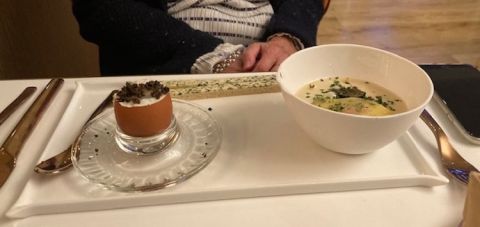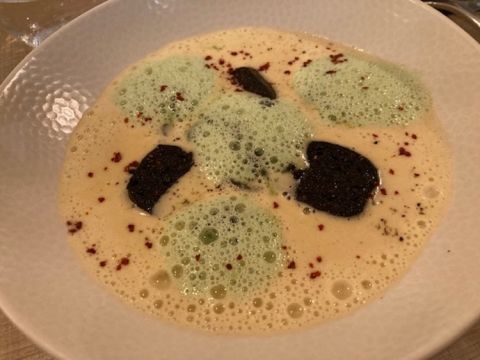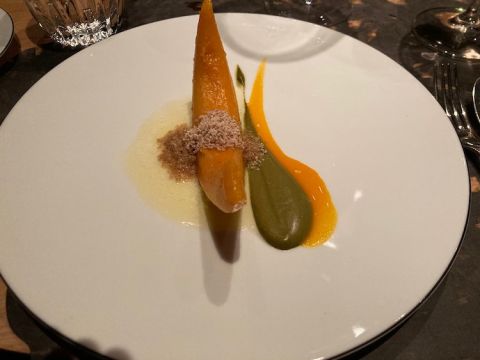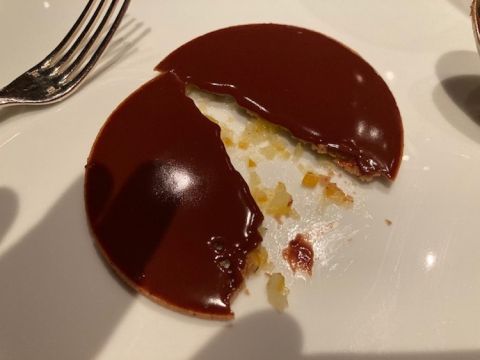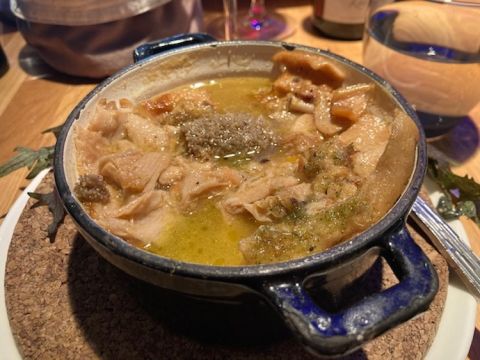Why do eating habits vary so enormously from country to country? This was the thought that kept bugging me after a fortnight in France recently.
In Burgundy – OK, home to a multitude of winemakers and with a rich tradition of eating substantially – there was barely an empty table in any of the restaurants we ate in, although the region itself was devoid of many of the tourists and wine-minded business travellers who normally visit this region to taste the young vintage in October and November.
Le Soufflot was almost full on a Monday lunchtime; Le Cellier Volnaysien, in the heart of Volnay, was packed on the Tuesday; on the Wednesday lunchtime, the car park outside the hotel Castel de Très Girard in Morey-St-Denis was absolutely full, mainly with expensive SUVs; and on the Friday lunchtime the packed scene at Le Complexe de Gevrey (effectively the popular canteen of the village sports hall) when we arrived at 12.45 can best be summed up as follows. There was the look of concern on the face of our waitress when we explained to her that we would like a table for three rather than for two, which we had originally booked; the restaurant was turning tables at 13.10; and by the time we came to order they had already run out of their daily special, cuisses de grenouille en persillade (frogs’ legs in a parsley sauce) et frites (€17) – a huge disappointment to me!
And it was the same at dinner. As we walked into the restaurant of the hotel in Morey-St-Denis, it was clear that the private dining room was already full of 12 cigar-smoking and champagne-drinking Frenchmen. On the other side of the glass screen separating this room from the main dining room where we had two good dinners, we enjoyed, on successive evenings, a fabulous first course: oeufs bio, truffes d’été de Bourgogne et Comté, a bowl of thick soup made from Comté, not unlike a fine cheese fondue, a couple of thin fingers of bread topped with butter and truffle cream, and a soft-boiled egg topped with black-truffle shavings (below).
For Friday-night dinner in Dijon with our man in Burgundy, Matthew Hayes, he recommended the Restaurant So, very close to this city’s spectacular, historic, centre. It too was full. This was an excellent recommendation of a restaurant run by a Japanese husband and wife, where he cooks and she runs the front of house. Two dishes in particular were spectacular: a combination of snails, black pudding and paimpol beans in a light parsley soup (pictured below); followed by a feuilleté de viande, a thick slice of a delicious amalgam of veal, duck, foie gras and sweetbreads wrapped in thin flaky pastry, served alongside a small green salad.
En route from Burgundy to our place in the Languedoc, we planned to spend the Saturday night near Roanne with longstanding friends of Michel and Marie-Pierre Troisgros (our friends feature in the Troisgros episode of The Chef’s Table, for instance). The week before, I proposed that we take them there for dinner. They immediately phoned to book a table only to be told that unfortunately all the tables were taken that night but that we would be put on a cancellation list. Happily, they did find us the table at which Michel T, plus mask, is seen in our main picture above.
Which led to us enjoying a tasting menu (€260 per person) proposed by César, the Troisgros’ elder son, now fully ensconced in the kitchen at their new property in Ouches, which featured the first game of the season: roe deer with ravioli of turnips filled with carrots, and two savoury dishes and one sweet. A slice of potimarron pumpkin with sorrel and buckwheat pictured above; langoustines, in a sauce redolent of the citrus acidity that characterises the current Troisgros cuisine, slices of sole topped with crisply sautéed mint leaves; and, possibly the dessert of the year (so far), called chocolat Narcissus. This was a disc of thin biscuit (below), slightly acidified, topped with a chocolate topping that was so clear and smooth that one could easily look into it and see one’s reflection. The dish – amazingly enough – successfully incorporated salted capers in both the biscuit and the accompanying ice cream.
With all this stunning solid matter we drank a bottle of Condrieu 2018 from Gangloff, kindly offered to us by the Troisgros; a bottle of Sancerre 2011 La Grande Côte from François Cotat that belied its age; and a bottle of Bandol 2010 La Tourtine from Domaine Tempier, in homage to the recently departed Lulu Peyraud, that would have been à point a couple of years ago.
Finally, there was the restaurant that Michel Troisgros had advised us to stop at for lunch on our long drive to the Languedoc. This was in the small town of Aumont Aubrac, in the region famous for Aubrac beef. As we drove through, the town seemed pretty deserted and quiet. But then we reached the car park outside the restaurant Chez Camillou run by Troisgros alumnus Cyril Attrazic.
We managed to secure a table so long as we promised to order a single dish and spend no more than 30 minutes at the table. This was long enough for us to enjoy the sight of a packed restaurant and for us to make one food and one wine discovery. The dish was described as pansettes de veau, veal tripe served with aligot potatoes, the local speciality of a rich, smooth mix of creamed potatoes and local cheese. What arrived was a cocotte dish filled with sliced vegetables, carrots, courgettes and turnips, topped with slices of different cuts of veal tripe (below). Not for everybody, perhaps, but a deliciously warming dish.
Jancis’s discovery was a half-bottle of Marcillac rouge from 2018, a hot vintage, from Domaine Laurens (at €12) that she enjoyed so much, she asked our waitress for a cork for it and took the bottle home with her. [It was so much fruitier and more welcoming than I remembered earlier vintages of Marcillac, based on the Fer Servadou grape, yet did not lack local personality – JR.]
All these meals reinforced my long-held opinion: that many if not most Frenchmen are trencher-men (the definition of which is someone who eats heartily) and that this definition applies equally to many French women.
Many of these restaurants were full for similar reasons to those which have been filling British restaurants – that with theatre, concert halls, opera and cinemas closed, there is little alternative to spending your evenings wining and dining. But it does not account for why so many restaurants were so busy at lunchtime.
There was no Eat Out to Help Out scheme. There was no discounted offer such as the FT’s old Lunch for a Fiver. All of these restaurants, even the Troisgros (at €120), do offer a fixed-price lunch menu, of course, and it is always difficult to see precisely who is taking advantage of the good deal offered at these, but a deal did not seem the primary attraction.
The main attraction seems to be that this country’s current enthusiasts for eating in restaurants are carrying on a long-established tradition, one that has existed in this country for far longer than in any other. Long may this tradition continue.
Le Soufflot 8 Route Nationale 74, 21190 Meursault, France; tel +33 (0)3 80 22 83 65
Le Cellier Volnaysien 2 Place de l'Eglise, 21190 Volnay, France; tel +33 (0)3 80 21 61 04
Le Castel de Très Girard 7 rue de Très Girard, 21220 Morey-St-Denis, France; tel +33 (0)3 80 34 33 09
Le Complexe de Gevrey Chemin de Champ Franc, 21220 Gevrey-Chambertin, France; tel +33 (0)3 80 42 56 59
Restaurant So 15 rue Amiral Roussin, 21000 Dijon, France; tel +33 (0)3 80 30 03 85
Troisgros 728 rue de Villeret, 42155 Ouches, France; tel +33 (0)4 77 71 66 97
Chez Camillou 10 route du Languedoc, 48130 Aumont-Aubrac, France; tel +33 (0)4 66 42 86 14


